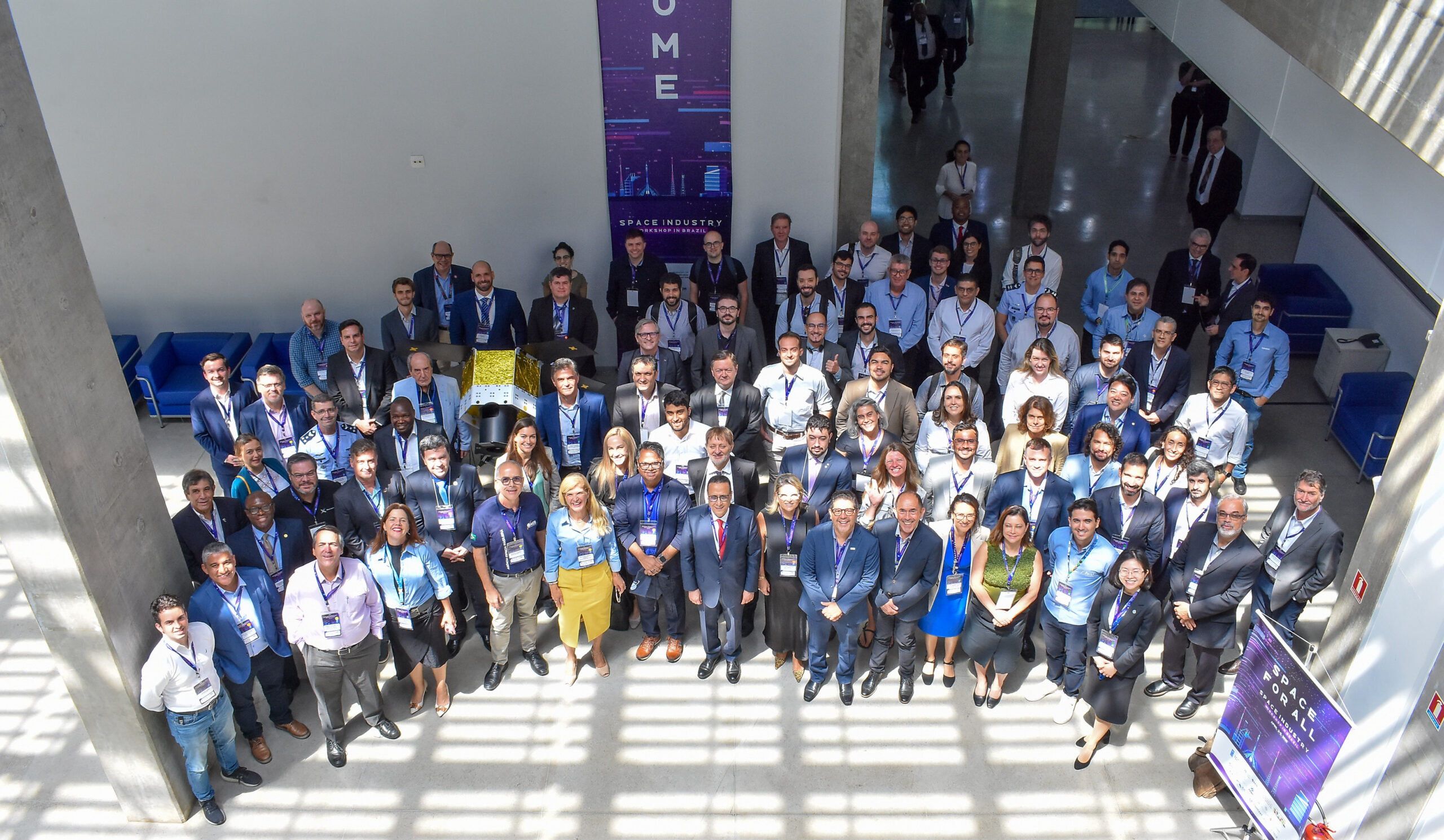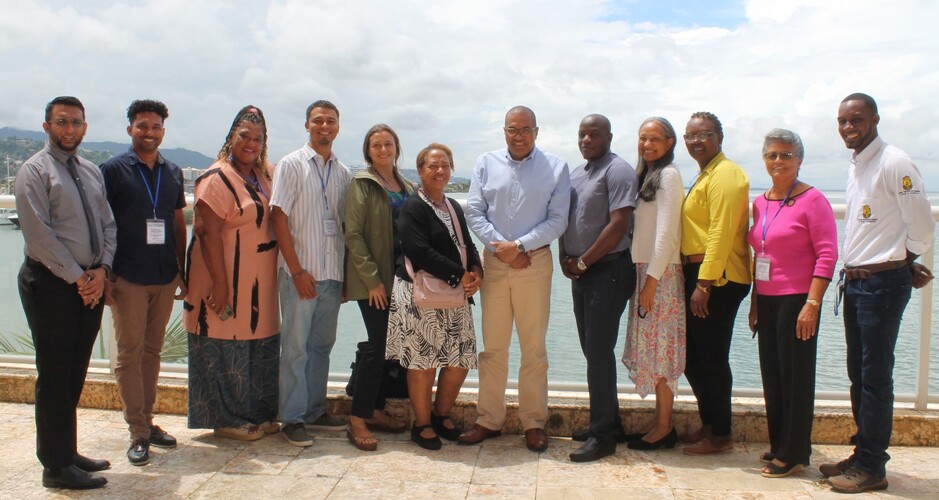Written by:

Dr Laura Canevari
CEO

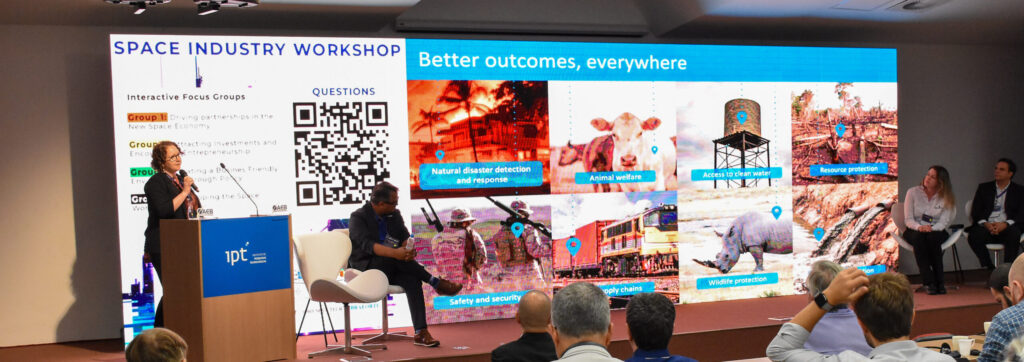
Two days immersed in the Brazil Space Workshop was not something I had anticipated as part of my usual climate resilience calendar. But what I discovered was a surprisingly fertile ground—not just for awe-inspiring technology, but for real, grounded opportunity.
The space sector is undergoing a profound global transformation, shifting from exclusivity to democratized access. Lower launch costs, public-private partnerships, and startup innovation are opening space to new players, including developing nations. As Rodrigo Leonardi from the Brazilian Space Agency (AEB) emphasized, Brazil’s vision is to translate space activity into real economic value: “Space must become a sustainable activity that translates into economy.”
Latin America, and Brazil in particular, have the chance to not just participate in this economy—but shape it with purpose. But leading in the space industry requires more than launching satellites—it demands building market connections and driving economic sustainability. This first-of-its-kind workshop in Brazil focused precisely on strengthening the links between space-based technologies—such as Earth observation, satellite connectivity, and remote sensing—and sectors like agriculture, water management, logistics, transport, communications, and disaster risk management.
This blog reflects on key takeaways from the workshop, not through the lens of lunar dreams, but from the standpoint of Earth—and what orbiting the Earth can do for it, especially as it comes to building climate resilience.
A trillion-dollar opportunity… with Earth in mind
According to WEF and McKinsey (2024), the total value of global space in the economy was $630 billion in 2023 and will reach $1.8 trillion by 2035. That’s not just satellites and rockets—that’s data, connectivity, logistics, biotech, and Earth systems applications. Moreover, the economic benefit of Earth Observation for other industries is projected to be around $3.8 Trillion between 2023 and 2030 (WEF and Deloitte, 2024).
As noted by Patrick Pils from Leto Space, to realize this potential, the space sector must “go beyond the bubble” by engaging deeply with non-space industries, understanding their needs, and translating space capabilities into measurable value and impact. The narrative must shift from tech-focus to value focused and actors need to speak the language of different sectors: from mining to agriculture, from transport to energy.
Patrick identified six domains that bring value to other industries, namely: communication; technology transfer; position, navigation and timing; space-based energy; observation and measurement; and microgravity. Each node in a value network for one of these domains will be grounded on its own infrastructure, hardware, software, application, service and benefit; and benefits at one node of the network will be the base for the next infrastructural node. As with the example provided below, which illustrates the value network for emissions monitoring activities, the more downstream in the value network, the more the services and benefits are for non-space industries.
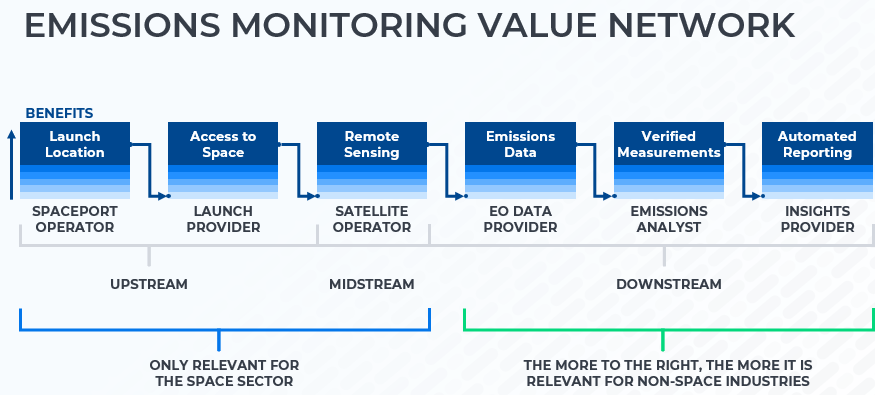 Emissions Monitoring Value Network. Patrick Pils, Leto Space (2025)
Emissions Monitoring Value Network. Patrick Pils, Leto Space (2025)
As the space industry grows, its success will depend on bridging the gap between upstream innovation and downstream impact—delivering value not only for corporations and governments, but for communities, ecosystems, and everyday lives.
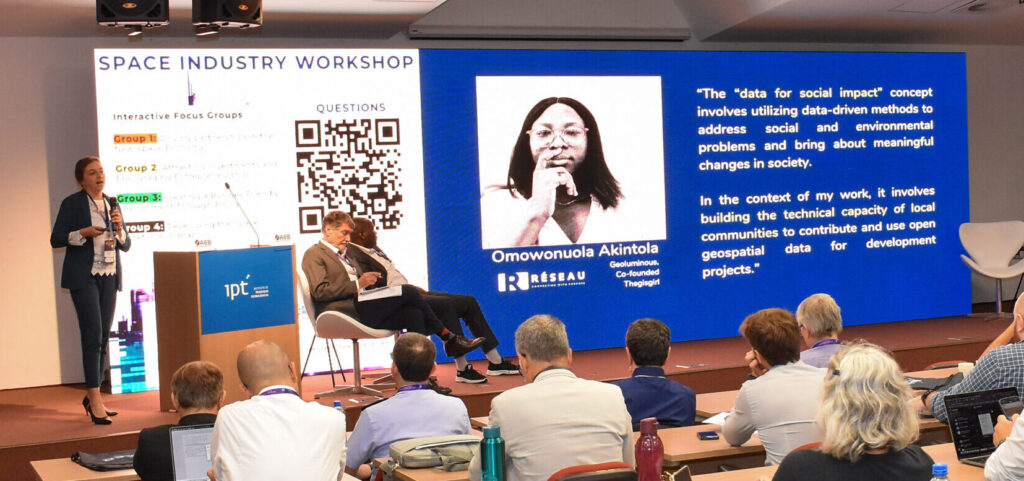
From satellites to soil – from food on Earth to flowers on the Moon
Earth Observation (EO) is the most mature link between space and climate. We’ve known this. But as Aravind Ravichandran of Terrawatch Space explained, the real bottleneck isn’t the lack of satellite data—it’s our ability to translate it into insight, and insight into decision-making.
In agriculture, this translation from data to decision-making is already well underway. At the workshop, we saw compelling examples such as Wyvern’s hyperspectral imaging, which enables farmers to optimize fertilization based on subtle spectral signals invisible to the human eye—reducing emissions, lowering costs, and improving yields. These advancements build on the foundational work of global institutions like the Group on Earth Observations (GEO), Copernicus, and NOAA, which have each played a distinct role in making Earth observation tools more accessible and actionable. GEO, for example, has been instrumental in promoting the use of Earth observation for sustainable agriculture through its flagship GEOGLAM initiative, which improves crop monitoring and food security through global coordination and capacity building. On the other hand, Copernicus, the EU’s Earth observation programme, provides open-access, high-resolution data through missions like Sentinel-2, widely used for vegetation monitoring and precision farming. Last but not least, NOAA, through its long-standing satellite programmes and climate services, has developed crucial agroclimatic datasets and early warning systems that support farmers in managing climate risks.
Together, these efforts have created the data infrastructure, standards, and enabling environment that allow newer commercial actors like Wyvern to build targeted, high-value services for agriculture—and for climate adaptation more broadly.
Now, while EO helps optimize agriculture from above, others are rethinking agriculture from within—by designing “spaceships for plants,” both on Earth and in orbit. As Barbara Belvisi of Interstellar Lab explained, their AI-powered biopods simulate entire ecosystems to grow delicate, high-value species under fully controlled conditions. Originally developed for space applications, these systems now hold powerful lessons for Earth. In water-scarce regions or degraded soils, where traditional farming is no longer viable, closed-loop bioponic systems offer a glimpse of climate-resilient agriculture—low-input, high-efficiency, and radically adaptable.
Their upcoming Little Prince Mission, which will grow and harvest flowers on the Moon, may seem whimsical—but the science behind it is anything but. Growing plants in extreme environments requires innovations in climate control, nutrient cycling, and microbial balance—advancements that have direct relevance for Earth-based challenges like desert agriculture, vertical farming, and ecosystem restoration. What space teaches us here is not just how to grow in zero gravity, but how to grow with zero waste, minimal resources, and maximum intelligence.
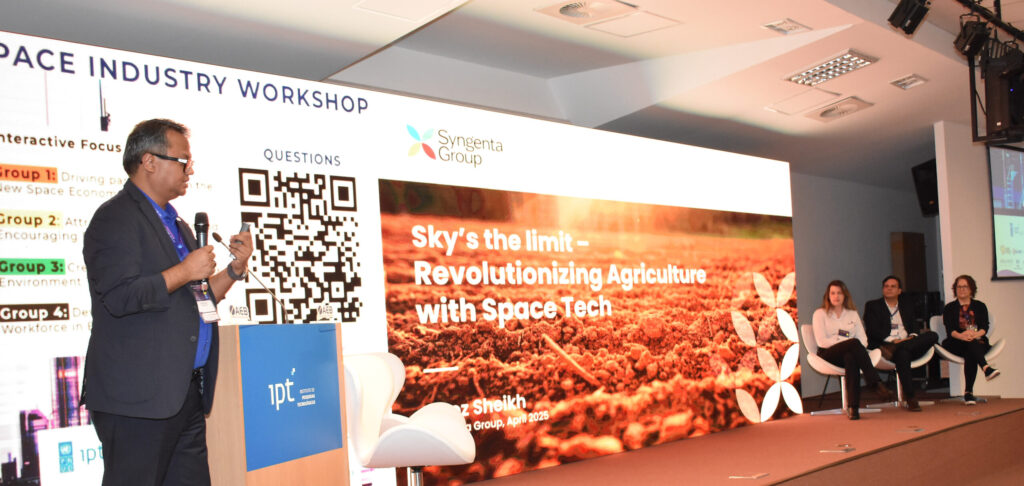
Microgravity manufacturing: Innovation where gravity can’t go
Rafael Roettgen of E2MC Space brought attention to microgravity as the next industrial frontier. In orbit, proteins crystallize with higher purity, stem cells behave differently, and materials form in novel ways. What used to be science fiction—like manufacturing replacement human retinas in space—is now entering startup pipelines. As the cost of launch decreases, manufacturing in microgravity becomes viable.
As climate risks augment at accelerated rates, may we find in microgravity manufacturing a solution to the costs and challenges of manufacturing some climate technologies on Earth?
The Enablers: Parallel paths, shared struggles
The workshop didn’t just celebrate innovation—it wrestled with the hard stuff. Focus groups on policy, capital, and talent pointed to shared pain points across both space and climate sectors:
- The need for governments to act not just as regulators, but as anchor customers and ecosystem conveners
- The scarcity of capital that understands frontier tech in practical, patient ways
- The critical role of incubators, accelerators, and supply chain connectors in translating innovation into market value
We were reminded that ecosystems don’t emerge from invention, but that they grow through coordination. Moreover, there is a deeper alignment between the space industry and climate action:
- Both must translate knowledge across technical and non-technical domains
- Both require integration of fragmented supply chains
- Both are challenged by trade and regulatory barriers for tech transfer
- And both must scale fast while staying grounded in public trust
Perhaps most importantly, both are about building resilience in the face of complexity—whether it’s climate volatility or orbital risk.
What can the climate sector learn from space?
The space industry reminds us that bold framing matters. That symbols can move markets. That poetic missions—like growing flowers on the Moon—can drive real investment and public interest.
But beyond the inspiration, we see an industry building infrastructure for complexity: real-time data, automated systems, modular innovation platforms, global supply chains. These are not luxuries—they are necessary tools in our climate action toolkit.
It’s time for climate practitioners to embrace space not just as a metaphor, but as a partner. Not just for satellite-based monitoring, but for a wide range of applications that directly support adaptation and resilience goals. From agriculture and water management to disaster risk reduction, early warning systems, public health, infrastructure monitoring, energy planning, biodiversity conservation, urban development, and sustainable transport—space-based technologies are already providing data, services, and innovations that can transform how we respond to climate risks.
The challenge is no longer technological possibility, but practical integration. As the space sector continues to lower barriers to access and expand commercial services, the opportunity for the climate community is clear: to forge new partnerships, shape demand, and co-develop solutions that bring space down to Earth where it’s needed most.
What further can the space industry do for climate?
The space industry can have an immense role to play in helping countries meet their climate commitments. From precision data for national adaptation plans to satellite-driven early warning systems, space-based capabilities are critical enablers of climate resilience, mitigation, and sustainable development. But unlocking this potential requires deeper integration into climate planning processes, more investment in user-friendly applications, and intentional partnerships with communities, civil society, and local governments.
At ITACA, we’ve always believed in crossing disciplines to build resilience. After Brazil, that belief now includes a new direction: looking up—and building forward. After Brazil, that belief now includes a new direction: looking up—and building forward.
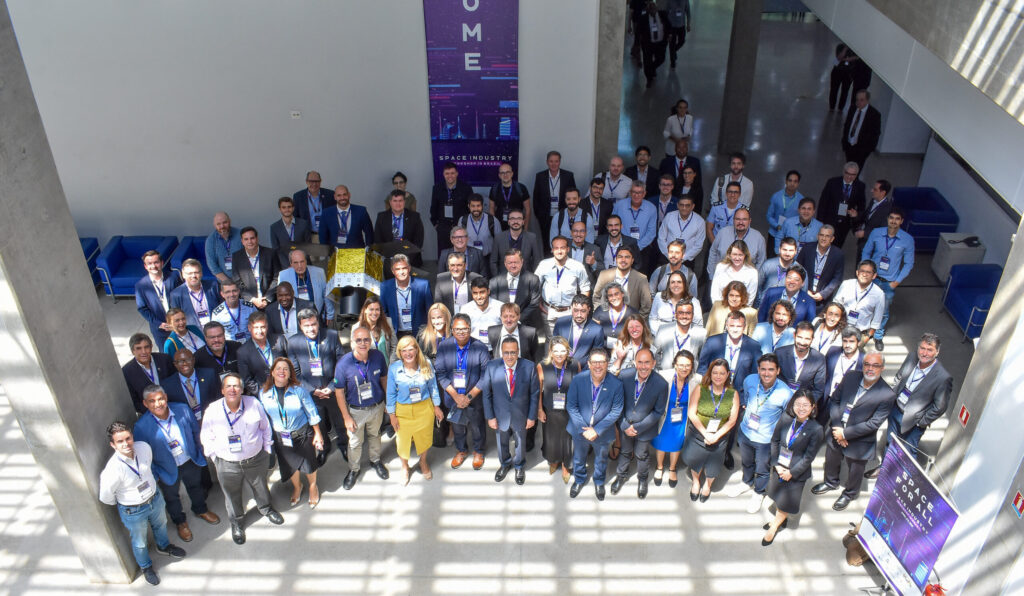
Related posts
sign up our newsletter
ITACA Solutions is a technical services provider focused on implementing climate adaptation in coastal areas in the Caribbean. Sign up to our mailing list to receive our newsletter with updates about our work, publications, activities and events.

